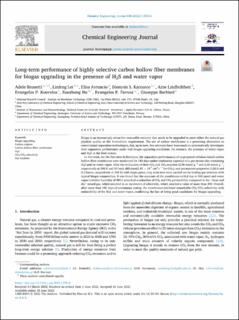Long-term performance of highly selective carbon hollow fiber membranes for biogas upgrading in the presence of H<inf>2</inf>S and water vapor
| dc.contributor.author | Brunetti, Adele | |
| dc.contributor.author | Lei, Linfeng | |
| dc.contributor.author | Avruscio, Elisa | |
| dc.contributor.author | Karousos, Dionysis S. | |
| dc.contributor.author | Lindbråthen, Arne | |
| dc.contributor.author | Kouvelos, Evangelos P. | |
| dc.contributor.author | He, Xuezhong | |
| dc.contributor.author | Favvas, Evangelos P. | |
| dc.contributor.author | Barbieri, Giuseppe | |
| dc.date.accessioned | 2023-12-11T10:08:42Z | |
| dc.date.available | 2023-12-11T10:08:42Z | |
| dc.date.created | 2022-06-27T08:45:13Z | |
| dc.date.issued | 2022 | |
| dc.identifier.issn | 1385-8947 | |
| dc.identifier.uri | https://hdl.handle.net/11250/3106809 | |
| dc.description.abstract | Biogas is an increasingly attractive renewable resource that needs to be upgraded to meet either the natural gas pipeline quality or the biomethane requirement. The use of carbon membranes is a promising alternative to conventional separation technologies, but, up to now, few attempts have been made to systematically investigate their separation performance under real biogas upgrading conditions, for instance, the presence of water vapor and H2S in the feed stream. In this work, for the first time in literature, the separation performances of as-prepared cellulose-based carbon hollow fiber membranes were monitored for 183 days under continuous exposure to a gas stream also containing H2S and/or water vapor. After the evaluation of their CO2 and CH4 sorption (2,98 mmol g−1 and 2,00 mmol g−1, respectively at 298 K and 10 bar), diffusion(2.45 × 10-7 cm2 s−1 for CO2), and permeation properties (120.9 and 2.3 barrer, respectively at 308 K) with single gases, long-term tests were carried out by feeding gas mixtures with typical biogas composition. It was found that the exposure of the membranes to H2S (up to 500 ppm) and water vapor (relative humidity of 90%) provoked a reduction of CO2 and CH4 permeability compared to the “clean and dry” mixed gas, which resulted in an increment of selectivity, which reached a value of more than 200. Overall, after more than 180 days of continuous testing, the membranes exhibited remarkable CO2/CH4 selectivity with endurability of the H2S and water vapor, confirming the fact of being good candidates for biogas upgrading. | en_US |
| dc.language.iso | eng | en_US |
| dc.publisher | Elsevier B. V. | en_US |
| dc.rights | Navngivelse-Ikkekommersiell 4.0 Internasjonal | * |
| dc.rights.uri | http://creativecommons.org/licenses/by-nc/4.0/deed.no | * |
| dc.title | Long-term performance of highly selective carbon hollow fiber membranes for biogas upgrading in the presence of H<inf>2</inf>S and water vapor | en_US |
| dc.title.alternative | Long-term performance of highly selective carbon hollow fiber membranes for biogas upgrading in the presence of H<inf>2</inf>S and water vapor | en_US |
| dc.type | Peer reviewed | en_US |
| dc.type | Journal article | en_US |
| dc.description.version | publishedVersion | en_US |
| dc.source.volume | 448 | en_US |
| dc.source.journal | Chemical Engineering Journal | en_US |
| dc.identifier.doi | 10.1016/j.cej.2022.137615 | |
| dc.identifier.cristin | 2035208 | |
| dc.source.articlenumber | 137615 | en_US |
| cristin.ispublished | true | |
| cristin.fulltext | postprint | |
| cristin.qualitycode | 2 |

